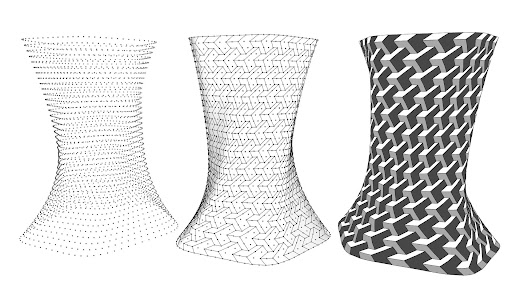IAAC – Master in Robotics and Advanced Construction
Software I seminar
Faculty: Andrea Graziano
Faculty Assistant: Eugenio Bettucchi
INFORMED GEOMETRIES
Credits: Non-standard tessellation study, Co-de-iT (2018)
The main theme of the Software I seminar will be a focus on information as geometry and design substrate; a better understanding of geometries syntax structure, representation and its information articulation leads to a wider and creative use of them in computational design strategies driving to new design opportunities and implementations both in architectural project, digital fabrication strategies and possibly robotics processes. The seminar will be divided into three parts:
The first part will be a lecture about NURBS geometries, robotic tool-paths and the so called “continuous processes”; 3D-printing is one of the many and industry and robotic brands are looking for a better integration of these processes but there are some considerations to be done.

Credits: Mesh topology study, Co-de-iT (2016)
In its second part, the seminar will focus on mesh syntax and topology, its design and fabrication implications. The exploration and the use of different topologies configurations over the same geometry leads to disparate outcomes in terms of aesthetic and performative qualities, mesh behaviour during dynamic relaxation and digital fabrication implications.
The third part will focus on advanced data trees syntax and operations and their use in computational design strategies implementation ranging from non-standard facade tessellation to non-standard 3d printing deposition methods and toolpaths. Being able to navigate complex data structures and to address information through it is a necessary skill.
Learning objectives
At course completion the student will learn:
- Learn mesh geometry syntax and features, topology structure and inherent opportunity
- Learn algorithmic strategies to approach computational design, digital fabrication and material systems explorations.
- Learn how to use advanced data trees syntax to manage data structure complexity.
- Be able to encode/decode data into/from geometry and exploit its spatial-topological structure to support design strategies.
- Develop a better sensibility and understanding in the articulation and use of information to inform geometries (i.e. to give form).
